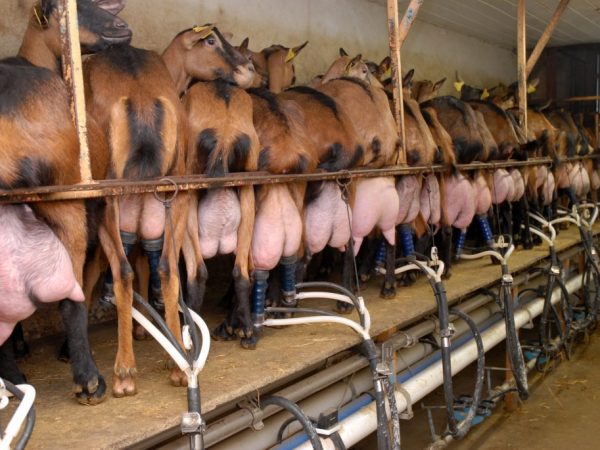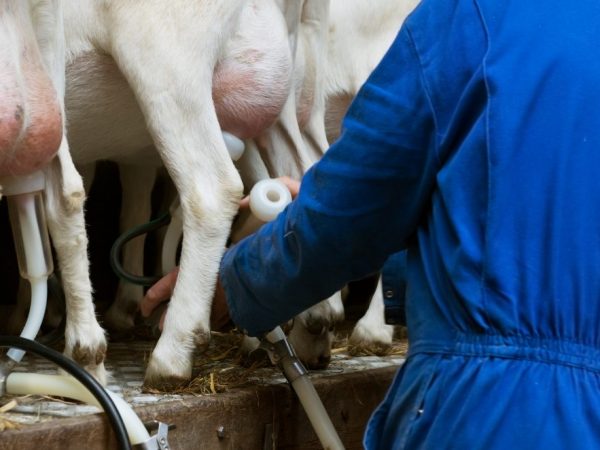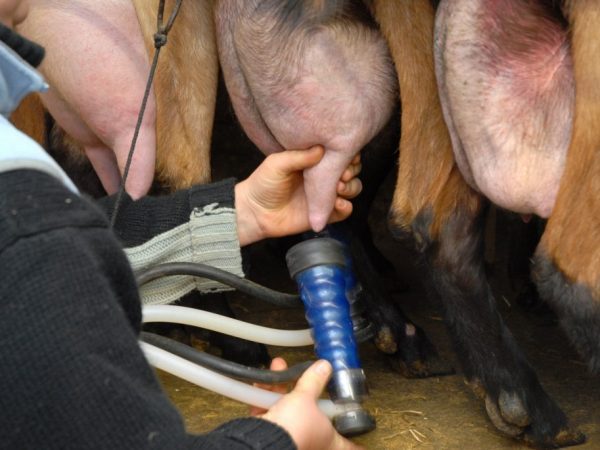Tips for making a goat milking machine
To obtain milk and dairy products, farmers often have a goat on the farm. The burenka is not always convenient for keeping: she requires more food, she needs a larger shed and she is expensive. But milking problems remain, no matter which animal the owner maintains. For those who find it difficult to carry out this procedure, there is a milking machine for goats. It is quite possible to either buy it or make it yourself. Let's consider how to make a do-it-yourself goat milking machine.

Milking machine for goats
Milking machine rules
Although milking machines for goats make it easier to obtain milk, their use requires some knowledge from the owner. All hygiene rules must be followed during the milking process. You should not start this procedure without washing your hands and cleaning the device itself. It is recommended to carefully clean the udder from excess hair. The first streams of milk are usually collected in separate containers as they contain dirt and bacteria. After each use, the milking cluster is thoroughly cleaned of dirt and milky streaks.
Regardless of whether a home-made machine is used or milking machines for goats from the manufacturer are used, the animal must be accustomed to them. A handheld milking machine can scare a pet, so at first it should be calmed and nearby. This recommendation applies to both a home-made device and one that had to be bought ready-made.
Milking machine parts
Let's consider what the milking machine consists of:
- The main element of any such design is the vacuum pump, which is the main labor force. It is worth taking a pump whose power is approximately equal to that of industrial devices.
- Pulsator. In theory, some craftsmen are able to assemble it with their own hands, but this requires engineering skills and a large set of tools. Usually such pulsators are bought on the market.
- Collector for collecting milk. This device distributes the impulse from the pulsator to all the cups attached to the udder. It has a complex design that is not easy to reproduce at home.
- Milk pumping hoses. Transparent silicone hoses are usually chosen as they are best suited for this purpose. With them, it is convenient to monitor how the liquid flows, and it is also easy to wash them.
- Udder cups. These cups are usually fitted with silicone inlays so as not to injure the animal. Again, you can buy them, or you can assemble them yourself.
- Milk milk container. Usually, a can, bucket or canister is used for this purpose. However, it is not recommended to use plastic. A metal container, for example, stainless steel, is much better suited here.
Before buying, they decide which parts of the mini-version of the milking machine for goats can be assembled with their own hands, and which will have to be bought.After that, they evaluate all the costs and decide which is more convenient: buy a unit or still assemble it manually.
A person without engineering knowledge and skills should not try to make such a device.
Milking machine pump selection

DIY apparatus
To make a do-it-yourself goat milking machine, you need to choose the right parts for it. A suitable pump is selected first. A manual drive can be used instead.
Making a hand-drawn pump is not very attractive for a number of reasons. The first is the low power of such a unit, which makes it possible to milk only 1-2 animals at a time, and this is inconvenient for owners of large farms. The second is the unevenness of the pulses during milking. The hand pump requires uniform, methodical inflation, as the animal always gets used to the same rhythm. And if you milk it with a different amplitude, the volume of milk received will greatly decrease. Finally, even servicing one mini-unit requires some effort: the manual drive requires constant, methodical work in the process of milking a goat.
If the farm has a cow, it is better to either milk it manually or use an automatic unit. Here you need to choose which pump will be convenient for a homemade device. Vacuum pumps are either electric or oil type. Oil oils are often used in industrial conditions, but they also have their drawbacks.
When assembling the milking cluster, you have to choose between an electric and an oil pumping unit. And here it is better to prefer the electric version: with any leakage, oil enters the system, then all the milk yield has to be thrown away.
Self assembly
If desired, you can also make a homemade design that will provide sufficient power when the milking machine is operating. A small compressor, such as an old vacuum cleaner or similar device, works best. Engine power at the level of 0.4-0.5 kW is sufficient for efficient operation. Some Soviet vacuum cleaners have a power of 0.6-0.7 kW, which may be enough even when assembling a milking machine for two goats.

When manufacturing, it is important to follow all recommendations.
There are a number of manufacturing guidelines. First, it is worth using a capacitor to suppress network noise to ensure uniform pumping. This detail is always present in a vacuum cleaner. Secondly, excess power can be extinguished using a conventional lamp connected to the device. An incandescent lamp with a power of 50, 100 or 200 W will do, depending on the strength of the vacuum cleaner. Finally, it is advisable to check the stability of the electric pump: whether there are any short circuits in the network, whether the winding has burned out.
Choice of pulsator and collector
If the pump can still be made from an old compressor, the pulsator and manifold are usually purchased. These two parts are usually sold separately, neither industrial nor homemade apparatus can do without them. The pulsator emits uniform pulses similar to the sucking of a kid, and the manifold distributes pressure and vacuum across all the teat cups. Without such an even distribution, normal and efficient milking is impossible.
There is also such an apparatus as a pulse collector: a pulsator and a collector assembled into one whole. In most cases, the price of such a paired device is slightly lower than the cost of its two components separately. A cheap device will have to be manually cleaned and sorted out, and an expensive one may not be affordable. The price even for an inexpensive pulsator is 1300-2000 rubles and more. The collector costs 300-600 rubles.
Apparatus brands
There are several models that you can either purchase ready-made or use their spare parts for assembly. For example, the Squirrel apparatus (Squirrel 1 mini, Squirrel 2), with the help of which it is possible to provide care for a herd of up to two dozen heads. Squirrel 1 mini will cost the farmer relatively inexpensively, only 13-14 thousand rubles.For the owner of a backyard, something like a Mayga apparatus is best suited. This is a simple and convenient design, the price of which is 4-5 thousand rubles, depending on the region.
It is the spare parts of these devices that are best paid attention to when assembling. If you need to milk 4-5 goats at the same time, you can pay attention to the Doyushka apparatus. However, it will cost 18-20 thousand rubles, so it should only be taken by owners of large farms.
Conclusion
An inexpensive and convenient manual milking machine for goats can be assembled independently, but the assembly must be approached responsibly and wisely.


